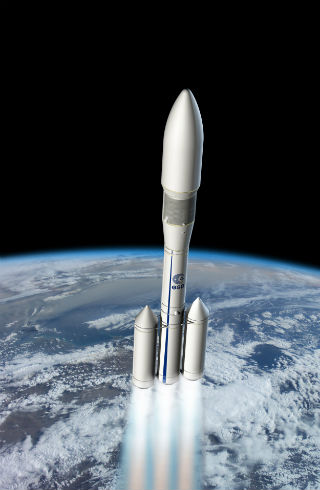The European Space Agency on 9 July unveiled its baseline configuration for the Ariane 6 heavylift launcher that is being readied to replace the in-service Ariane 5 from about 2021.
 |
|---|
ESA |
As outlined at the November 2012 member states ministerial conference, which gave the project the green light, Ariane 6 will look to reduce costs, and increase flexibility, by replacing Ariane 5's cryogenic main stages with a modular, solid-fuel first and second stage configuration topped by a reignitable cryogenic fuel upper stage. That upper stage will be an adapted version of the Ariane 5 ME upper stage, equipped with the Snecma Vinci engine and specific propellant tanks.
The 5.4m (18ft) diameter payload fairing will be able to accommodate the same volume of satellites as Ariane 5.
But the first and second stages, dubbed a "multi P linear" concept, are based on a first stage of three motors arranged in-line, topped by a single unit for the second stage. These four motors, each loaded with around 135t of solid propellant, will be closely based on the ESA's Vega small launcher.
Ariane 6 is intended to lift payloads of between 3t and 6.5t to geostationary transfer orbit, suitable for orbiting the telecommunications satellites that make up many of Ariane 5's missions, along with government payloads.
The Ariane 6 concept image unveiled on 9 July resembles closely the concept presented following the Naples ministerial meeting. The ESA and launcher prime contractor Astrium have been working fast since sign-off in November to get the programme under way. By January, the ESA had signed contracts worth €108 million ($138 million) to start Ariane 6 and to continue the parallel development of the so-called Ariane 5 ME (Midlife Evolution), and to find synergies between the two projects. Ariane 5 ME, which will fly from 2017, will boost payload by 20% to 12t to bridge the gap to Ariane 6.
Working with the ESA and Astrium on the Ariane 6 project are European experts in solid and cryogenic propulsion, structures, systems and avionics from Avio, Herakles, Safran, MT Aerospace and other companies.
Source: Flight International


























